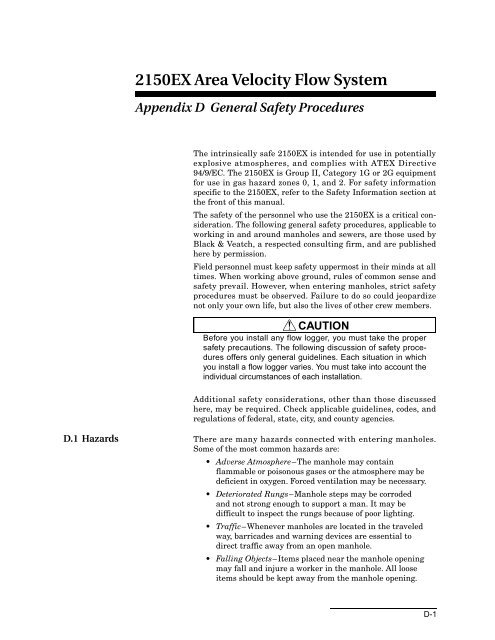2150EX AV Flow Module - Isco
2150EX AV Flow Module - Isco
2150EX AV Flow Module - Isco
Create successful ePaper yourself
Turn your PDF publications into a flip-book with our unique Google optimized e-Paper software.
<strong>2150EX</strong> Area Velocity <strong>Flow</strong> System<br />
Appendix D General Safety Procedures<br />
The intrinsically safe <strong>2150EX</strong> is intended for use in potentially<br />
explosive atmospheres, and complies with ATEX Directive<br />
94/9/EC. The <strong>2150EX</strong> is Group II, Category 1G or 2G equipment<br />
for use in gas hazard zones 0, 1, and 2. For safety information<br />
specific to the <strong>2150EX</strong>, refer to the Safety Information section at<br />
the front of this manual.<br />
The safety of the personnel who use the <strong>2150EX</strong> is a critical consideration.<br />
The following general safety procedures, applicable to<br />
working in and around manholes and sewers, are those used by<br />
Black & Veatch, a respected consulting firm, and are published<br />
here by permission.<br />
Field personnel must keep safety uppermost in their minds at all<br />
times. When working above ground, rules of common sense and<br />
safety prevail. However, when entering manholes, strict safety<br />
procedures must be observed. Failure to do so could jeopardize<br />
not only your own life, but also the lives of other crew members.<br />
CAUTION<br />
Before you install any flow logger, you must take the proper<br />
safety precautions. The following discussion of safety procedures<br />
offers only general guidelines. Each situation in which<br />
you install a flow logger varies. You must take into account the<br />
individual circumstances of each installation.<br />
Additional safety considerations, other than those discussed<br />
here, may be required. Check applicable guidelines, codes, and<br />
regulations of federal, state, city, and county agencies.<br />
D.1 Hazards There are many hazards connected with entering manholes.<br />
Some of the most common hazards are:<br />
• Adverse Atmosphere–The manhole may contain<br />
flammable or poisonous gases or the atmosphere may be<br />
deficient in oxygen. Forced ventilation may be necessary.<br />
• Deteriorated Rungs–Manhole steps may be corroded<br />
and not strong enough to support a man. It may be<br />
difficult to inspect the rungs because of poor lighting.<br />
• Traffic–Whenever manholes are located in the traveled<br />
way, barricades and warning devices are essential to<br />
direct traffic away from an open manhole.<br />
• Falling Objects–Items placed near the manhole opening<br />
may fall and injure a worker in the manhole. All loose<br />
items should be kept away from the manhole opening.<br />
D-1
















